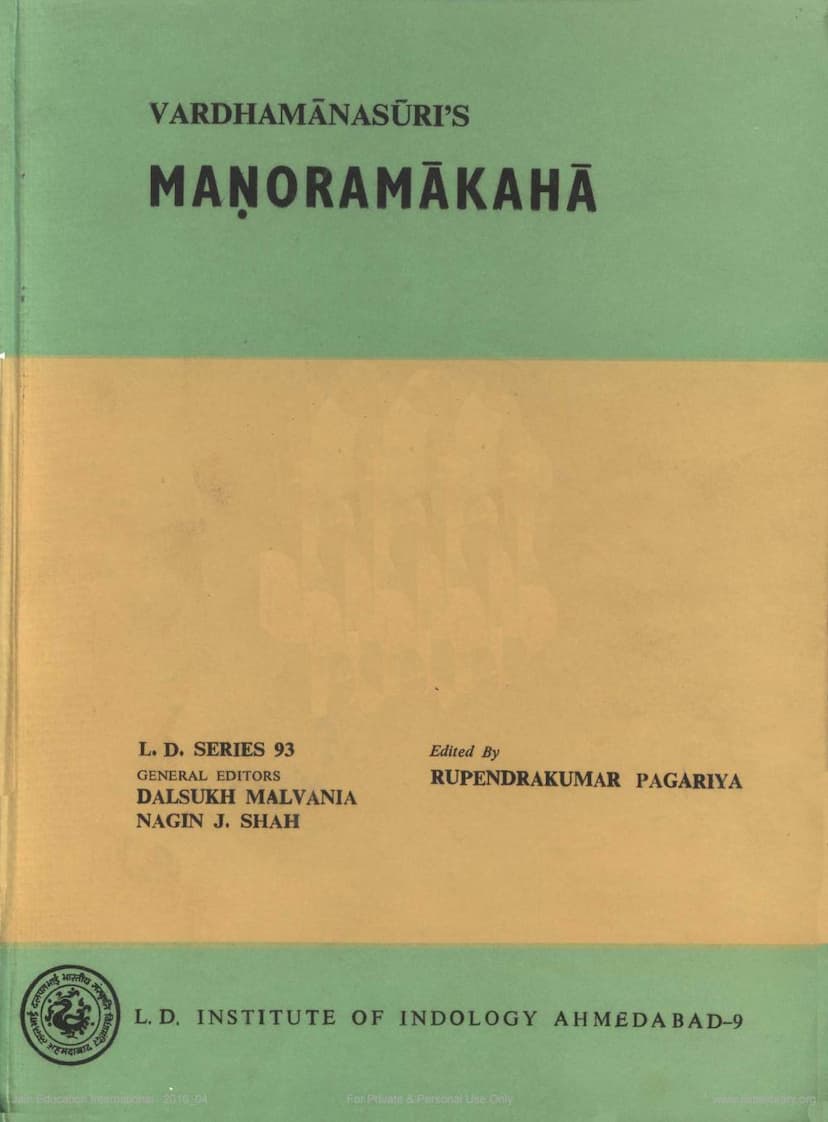Manorama Kaha
Added to library: September 2, 2025

Summary
Here is a comprehensive summary of the Jain text "Manorama Kaha" by Vardhmansuri, edited by Rupendrakumar Pagariya, published by L. D. Indology Ahmedabad, based on the provided pages:
Book Title: Manorama Kaha Author: Vardhamanasuri Editor: Rupendrakumar Pagariya Publisher: L. D. Institute of Indology, Ahmedabad Publication Year: First Edition, July 1983 Language: Prakrit (with extensive Hindi preface and introduction)
Overview:
"Manorama Kaha" is an extensive didactic-narrative work in Prakrit, composed by the 12th-century Jain monk Vardhamanasuri. The work, consisting of prose and verse, is a collection of numerous illustrative tales designed to preach various popular tenets of Jainism. The preface highlights its value for linguistic and cultural studies due to its realistic characters, lively descriptions, and the inclusion of folk tales with parallels in various Indian and international literary traditions.
Key Features and Content:
-
Structure and Extent: The story is divided into four "Avantaras" (sections or opportunities), each illustrating a specific stage of spiritual development. The work is voluminous, estimated to be equivalent to 16,000 verses (sloka-pramana) and contains approximately 80 tales, some of which are extensive and feature emboxed narratives.
-
Didactic Purpose: The primary aim of "Manorama Kaha" is to convey Jain ethical principles and teachings through engaging stories. Topics covered include the fruits of right religious faith (samyaktva), the practice of vows, charity, austerity, renunciation, and adherence to the five major and seven minor vratas (vows).
-
Content and Themes:
- Illustrative Tales: The book features over eighty-seven tales, many of which are popular folk tales. These tales illustrate Jain principles through the lives of kings, ministers, merchants, ascetics, and common people.
- Folk Literature Integration: A significant aspect of the work is its incorporation of folk tales, some of which are identified as having parallels in various Indian texts like Jatakas, Pancatantra, and Varta literature. Examples cited include the tale of Shilasundari (illustrating chastity), the rogue Vacanasara (The Rich and Poor Peasant), and the royal monk Yava (Doctor Know-All).
- Realistic Portrayal: The narrative style captures glimpses of the social strata of Gujarat and Rajasthan during the 11th century, offering valuable socio-cultural insights. The author's storytelling prowess is evident in his racy, conversational style, vivid dialogues, and balanced use of ornate and simple language.
- Linguistic Interest: The work offers linguistic richness with syntactic features like verb-subject-object sequences and numerous desya (local) words, valuable for New Indo-Aryan lexicology. The Apabhramsa passages are significant for understanding the language of Hemachandra's period, including metrical forms like Doha, Rasavalaya, Satpada, and Vadanaka.
- Detailed Story Summaries: The "Anukramanika" (Table of Contents) lists the stories, categorized by the four Avantaras. The introduction and preface provide detailed summaries of the main narrative arc, following the transmigration of the main characters across four lifetimes, culminating in their liberation (moksha).
-
Characters and Their Journeys (Four Avatars):
- First Avatar: Features King Narakesari and Queen Rambhavali. Through their experiences, they attain the seed of samyaktva (right faith).
- Second Avatar: Focuses on Samudradatta and Taravali, who embrace samyaktva in this life.
- Third Avatar: Depicts Bhurivasu and Ratnaprabha, who take on the vows of shravaka (lay followers).
- Fourth Avatar: Presents Shurasena and Manorama, who eventually become renunciates and attain nirvana (liberation).
-
Author and Transmission: Vardhamanasuri was a disciple of Abhayadevasuri, the renowned commentator of nine Jain Agamas. The critical edition by Rupendrakumar Pagariya is based on two manuscripts, one from the L. D. Institute of Indology and another from the Terapanthi Bhandar in Sardarpur, Rajasthan.
-
Contributions: The work is significant for preserving and presenting a rich collection of Jain narratives, blending religious teachings with elements of folk literature. The detailed description of the stories and their linguistic and cultural significance underscores its importance in Prakrit and Jain literature studies. The editor, Pt. Rupendrakumar Pagariya, is credited for his meticulous editing and the informative introduction.
Key Teachings Illustrated:
- Samyaktva (Right Faith): The importance of correct perception and belief in Jain principles is foundational.
- Vows (Vratas): The adherence to ethical vows is demonstrated through the characters' actions and their consequences.
- Karma: The concept of karma, the consequences of actions across lifetimes, is a recurring theme, explaining the protagonists' rebirths and experiences.
- Renunciation and Liberation: The ultimate goal of liberation (moksha) is shown as the final stage, achieved through spiritual discipline and detachment.
- Ethical Conduct: The stories emphasize virtues like truthfulness, non-violence, chastity, austerity, and compassion.
- Consequences of Sin: The text illustrates the dire consequences of transgressing ethical principles, such as violence, falsehood, theft, and lust.
Conclusion:
"Manorama Kaha" stands as a monumental work in Jain narrative literature, offering a blend of spiritual teachings, moral lessons, and captivating storytelling drawn from folk traditions. Its critical edition makes this valuable text accessible to scholars and students of Prakrit literature, Indian folklore, and Jain philosophy.